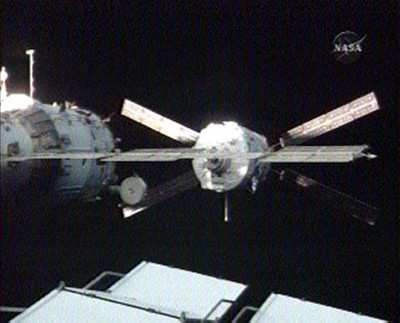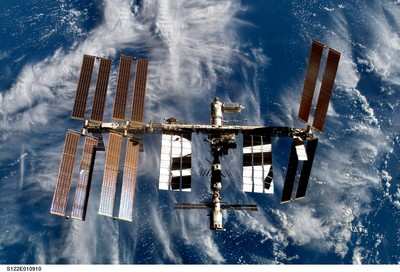ESA Marks First Successful Autonomous Propellant Transfer
The European Space Agency's Jules Verne ATV was used for the
first time this week to transfer in one step 811 kg of refueling
propellant to the International Space Station while the two
vehicles orbited Earth at 28,000 km/h. With this premiere for
Europe, Jules Verne becomes the first western spaceship to succeed
in refueling another space infrastructure in orbit.

It took less than half an hour to automatically transfer about
280 kg of the Russian UDMH (Unsymmetrical dimethylhydrazine)
propellant fuel and 530 kg of Nitrogen Tetroxide (N2O4), which
provides a source of oxygen so the fuel can ignite and burn in
orbit, to the International Space Station's (ISS) own Russian-built
propulsion tanks.
Because of the toxic and explosive characteristics of the
hydrazine, the transfer is done through dedicated pipes located
outside the pressurized structures of the Automated Transfer
Vehicle (ATV) and the Station. The fuel lines run from the ATV,
through the docking mechanism to the Space Station's own
plumbing.
 True to the ATV's mission, the ISS
crew was not involved in the refueling operation; at the time they
were busy preparing for a spacewalk scheduled for early July. ATV
was prepared for refuelling operations by ATV Control Centre in
Toulouse. After the necessary verifications to ensure no leakage
was present in the complete ATV piping system, Moscow Control
Centre initiated the automatic refueling procedure sequence, with
the active support of the small Engineering Support Team co-located
in the Moscow Control Centre.
True to the ATV's mission, the ISS
crew was not involved in the refueling operation; at the time they
were busy preparing for a spacewalk scheduled for early July. ATV
was prepared for refuelling operations by ATV Control Centre in
Toulouse. After the necessary verifications to ensure no leakage
was present in the complete ATV piping system, Moscow Control
Centre initiated the automatic refueling procedure sequence, with
the active support of the small Engineering Support Team co-located
in the Moscow Control Centre.
"We are impressed by this new achievement of Jules Verne ATV,
which went without a hitch. And we really have to congratulate the
teams of RSC Energia, Astrium and Thales Alenia Space for their
years of efforts to integrate the Russian refueling system in the
ATV from the hardware and software point of view" said Massimo
Cislaghi, ESA's leader of the Engineering Support Team.
As ANN reported, Jules Verne docked with the
ISS April 3... the first time a completely-automated vehicle had
docked with the station, with no human intervention.
That doesn't mean humans are completely removed from the proces,
however. During Wednesday's refueling operation, some 20 people
were working on the ISS in the Moscow Control Centre, with five
Russian ATV experts and thre ESA ATV specialists who all are part
of the Engineering Support Team located in Moscow. Meanwhile, 30
people were monitoring all ATV's critical functions at the ATV
Control Centre in Toulouse, where cheers and applause marked the
end of the fuel transfer.
The refuelling capabilities of ATV and the Russian Progress
capsules are identical with a maximum fuel load of 850 kg. While
ATV has about three times the payload capability of the Progress,
they use exactly the same tanks and the same interface through the
ATV docking mechanism with the Station.
The Russian ISS service module is the only Station element to
have a propulsion system, which allows to reboost the whole Station
in order to overcome the effects of residual atmospheric drag.
"We have now successfully performed all the nominal operations
of Jules Verne, such as the ISS attitude control, the ISS reboost,
the gas transfer of air, the water transfer, the dry cargo and now
the refuelling. Only undocking and re-entry remain, which we hope
to do in September," said Herve Come, ESA's ATV Mission Director at
the ATV Control Centre in Toulouse.

"Today, Europe has gained a new space capability which
represents a new step towards human spaceflights and advanced
exploration programmes", said Jean-Francois Clervoy, ATV senior
advisor and a member of ESA's Astronaut Corps. "ATV is the only
western vehicle able to refuel another spacecraft in complement to
the Russian Progress. The successful automation of this function
frees significant crew time for other ISS operations."
 ANN's Daily Aero-Linx (04.13.24)
ANN's Daily Aero-Linx (04.13.24) ANN's Daily Aero-Term (04.13.24): Beyond Visual Line Of Sight (BVLOS)
ANN's Daily Aero-Term (04.13.24): Beyond Visual Line Of Sight (BVLOS) Airborne 04.09.24: SnF24!, Piper-DeltaHawk!, Fisher Update, Junkers
Airborne 04.09.24: SnF24!, Piper-DeltaHawk!, Fisher Update, Junkers Aero-News: Quote of the Day (04.14.24)
Aero-News: Quote of the Day (04.14.24) ANN's Daily Aero-Term (04.14.24): Maximum Authorized Altitude
ANN's Daily Aero-Term (04.14.24): Maximum Authorized Altitude





